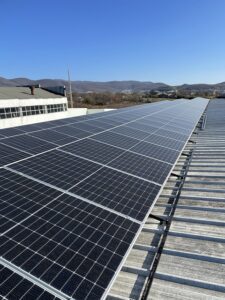
In the realm of renewable energy, solar power stands as a beacon of hope for a sustainable future. Over the years, solar panels have evolved from bulky, expensive installations to sleek, efficient systems adorning rooftops and sprawling across fields. But the journey doesn’t end here. Scientists and engineers are constantly pushing the boundaries of innovation to usher in the era of next-generation solar panels, promising even greater efficiency, affordability, and versatility.
So, what does the future hold for solar technology? Let’s delve into the exciting realm of next-generation solar panels and explore the advancements shaping our energy landscape.
The Rise of Perovskite Solar Cells
One of the most promising developments in solar technology is the emergence of perovskite solar cells. These cells are made using a class of materials known as perovskites, which exhibit exceptional light-absorption properties and can be easily synthesized using low-cost processes. Unlike traditional silicon-based solar cells, perovskite solar cells can be fabricated using simple techniques like solution processing, making them cheaper and more scalable.
Moreover, perovskite solar cells have demonstrated impressive power conversion efficiencies, rivalling conventional silicon cells. With further research and development, experts believe that perovskite solar cells could surpass the efficiency limits of silicon, potentially revolutionizing the solar industry.
Thin-Film Solar Technologies
Another avenue of exploration in the realm of next-generation solar panels is thin-film solar technologies. Unlike traditional solar panels, which are typically made from silicon wafers, thin-film solar cells are fabricated by depositing thin layers of semiconductor materials onto a substrate such as glass or plastic.
This approach offers several advantages, including flexibility, lightweight design, and potential for integration into various surfaces and applications. Companies and research institutions actively pursue advancements in thin-film solar technologies, aiming to improve efficiency, durability, and cost-effectiveness. Innovations in materials science and manufacturing processes are driving progress in this field, paving the way for thin-film solar panels to become a mainstream solution for renewable energy generation.

Tandem Solar Cells for Enhanced Performance
Tandem solar cells represent another frontier in next-generation solar panel technology. These cells consist of layers of different semiconductor materials, each optimized to absorb different portions of the solar spectrum. Combining materials with complementary absorption characteristics allows tandem solar cells to achieve higher efficiencies than single-junction cells. Researchers are exploring various configurations and combinations of materials to maximize the performance of tandem solar cells. Through precise engineering and innovative design, they aim to harness more sunlight and convert it into electricity with unprecedented efficiency. Tandem solar cells hold the potential to deliver breakthroughs in solar energy conversion, driving down costs and accelerating the adoption of renewable energy worldwide.
Integration with Energy Storage and Smart Grids
In addition to improving solar panels’ efficiency and performance, solar technology’s future lies in integrating energy storage systems and smart grid infrastructure. Energy storage technologies such as batteries enable solar power to be stored and utilized when sunlight is unavailable, enhancing the reliability and stability of solar energy systems. Furthermore, smart grid technologies facilitate the efficient distribution and management of solar energy, enabling seamless integration with existing power grids. By combining solar panels with energy storage and smart grid solutions, we can unlock the full potential of renewable energy, creating a more resilient
and sustainable energy ecosystem.
Modern Next Generation Solar Panels
Modern next-generation solar panels represent a significant technological leap forward, offering efficiency, affordability, versatility, and sustainability advancements. These panels incorporate innovative materials, manufacturing techniques, and design principles to overcome the limitations of traditional silicon-based photovoltaic (PV) cells. Here’s a closer look at some key features of modern next-generation solar panels:
Key features of modern next-generation solar panels:
1. Perovskite Solar Cells:
Perovskite solar cells have emerged as one of the most promising next-generation technologies. These cells utilize a class of materials called perovskites, known for their exceptional light-absorption properties and ease of fabrication. Perovskite solar cells can achieve high power conversion efficiencies comparable to or surpass traditional silicon cells.
Moreover, they can be manufactured using low-cost, solution-based processes, making them more affordable and scalable.
2. Thin-Film Solar Technologies:
Thin-film solar panels offer a lightweight and flexible alternative to traditional silicon-based panels. Instead of using rigid silicon wafers, thin-film panels are made by depositing thin layers of semiconductor materials onto a substrate, such as glass or plastic. This approach allows for greater installation flexibility and integration into various surfaces and structures. Thin-film technologies also have the potential to reduce manufacturing costs and improve energy efficiency.
3. Tandem Solar Cells:
Tandem solar cells combine layers of semiconductor materials to enhance light absorption and power conversion efficiency. By stacking materials with complementary absorption spectra, tandem cells can capture a broader range of sunlight and convert it into electricity more effectively than single-junction cells. This approach allows for higher efficiency and improved performance in varying light conditions.
4. Bifacial Solar Panels:
Bifacial solar panels capture sunlight from both the front and rear sides, increasing energy generation compared to traditional single-sided panels. These panels are designed to absorb sunlight reflected off surrounding surfaces, such as the ground or nearby buildings, in addition to direct sunlight. Beneficial technology enhances energy yield and provides greater installation flexibility, particularly in locations with high albedo or limited roof space.
5. Advanced Manufacturing Processes:
Modern next-generation solar panels benefit from advanced manufacturing processes that improve efficiency, reduce costs, and enhance product quality. Innovations such as roll-to-roll printing, laser processing, and thin-film deposition techniques enable faster production cycles and greater scalability. These manufacturing advancements contribute to the widespread adoption of solar energy by reducing costs and increasing accessibility.
6. Integration with Energy Storage and Smart Grids:
Next-generation solar panels are often designed to seamlessly integrate with energy storage systems, such as batteries and smart grid infrastructure. This integration enables efficient storage and solar energy utilisation, enhancing grid stability and reliability. By coupling solar panels with energy storage and smart grid technologies, it becomes possible to maximize the value of solar energy and optimize its contribution to the overall energy system.
Benefits of Next-Generation Solar Panels
1. Increased Efficiency:
Next-generation solar panels, such as perovskite and tandem solar cells, offer higher efficiency levels than traditional silicon-based panels. This means they can convert a greater percentage of sunlight into electricity, maximizing energy production and improving the overall performance of solar systems.
2. Cost-Effectiveness:
Many next-generation solar technologies, including thin-film solar panels and perovskite solar cells, are manufactured using less expensive materials and processes. This reduces production costs, making solar energy more affordable and accessible to a wider range of consumers and businesses.
3. Versatility:
Next-generation solar panels are often more versatile in terms of design and application. Thin-film solar technologies, for example, can be integrated into various surfaces and structures, offering flexibility in installation and enabling innovative solar solutions for urban environments, portable devices,
and curved surfaces.
4. Rapid Deployment:
The scalability and simplicity of manufacturing processes for next-generation solar panels facilitate rapid deployment of solar energy systems. With faster production cycles and easier installation methods, these technologies can accelerate the adoption of solar power globally, contributing to the transition towards renewable energy.
5. Durability and Longevity:
Materials science and engineering advancements contribute to the durability and longevity of next-generation solar panels. Enhanced resistance to environmental factors such as moisture,
temperature fluctuations, and UV radiation ensures prolonged performance and reliability, resulting in lower maintenance costs and greater overall value.
6. Integration with Energy Storage:
Next-generation solar panels can seamlessly integrate with energy storage systems like batteries to enable round-the-clock energy availability. By storing excess solar energy generated during peak sunlight hours, these systems can provide power during periods of low or no sunlight, increasing energy independence and resilience.
7. Environmental Benefits:
Switching to solar energy generated by next-generation solar panels reduces reliance on fossil fuels and mitigates greenhouse gas emissions, thus contributing to environmental sustainability and combating climate change. By harnessing clean, renewable sunlight, these technologies help preserve natural resources and protect the planet for future generations.
8. Grid Stability and Reliability:
Integrating next-generation solar panels with smart grid technologies enhances grid stability and reliability. Through advanced monitoring, control, and communication systems, solar energy can be efficiently distributed and managed, minimizing disruptions and optimizing the overall performance of the electric grid. Now, we are going to discuss about the advancements in community solar projects
Advancements in Community Solar Projects:

Increased Accessibility: Community solar projects enable individuals, businesses, and organizations to access the benefits of solar energy without the need for rooftop installations. Community members can subscribe to some of the generated electricity by participating in a shared solar array located off-site and receive credits on their utility bills.
Scalability and Flexibility: Modern community solar projects are designed to be scalable and adaptable to the needs of diverse communities. Developers can deploy solar arrays of various sizes and configurations, ranging from small installations serving a few households to larger projects powering entire neighbourhoods or municipalities.
Innovative Financing Models: Community solar projects often utilize innovative financing models, such as third-party ownership, power purchase agreements (PPAs), and community-based crowdfunding initiatives. These models help reduce upfront costs and make solar energy more accessible to a broader range of participants, including low-income households and underserved
communities.
Technological Advancements: Advancements in solar technology, such as developing more efficient photovoltaic (PV) panels and energy storage systems, enhance community solar projects’ performance and reliability. Integration with smart grid technologies and advanced monitoring systems further optimizes energy production and distribution.
Government Support and Policy Incentives:
Financial Incentives:
Federal, state, and local governments offer various financial incentives to support the development of solar energy projects, including community solar initiatives. These incentives may include tax credits, grants, rebates, and low-interest loans, which help offset installation costs and incentivize investment in renewable energy infrastructure.
Net Metering Policies:
Net metering policies allow solar energy system owners to receive credits for the surplus electricity they feed into the grid. This encourages participation in community solar projects by providing financial compensation for excess energy production and promoting the adoption of distributed solar generation.
Renewable Portfolio Standards (RPS):
Many jurisdictions have implemented Renewable Portfolio Standards (RPS) that mandate a certain percentage of electricity generation from renewable sources, including solar energy. These standards create demand for solar power and provide market certainty for developers of community solar projects.
Community Solar Programs and Policies:
Some governments have established specific programs and policies to support the development of community solar projects. These initiatives may include streamlined permitting processes, standardized contracts, and regulatory frameworks facilitating community participation and project development.
Equity and Inclusion Initiatives:
Increasingly, governments are prioritizing equity and inclusion in solar energy policies and programs, aiming to ensure that Underserved communities have equitable access to the benefits of solar power. This may involve targeted incentives, outreach efforts, and community engagement strategies to address barriers to participation and promote energy justice. Advancements in community solar projects, government support, and policy incentives are driving solar energy adoption worldwide expansion. By leveraging innovative technologies, financing models, and regulatory frameworks, communities can harness the sun’s power to create a more sustainable and resilient energy future for all.



